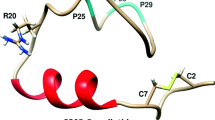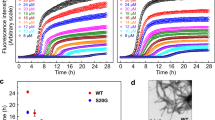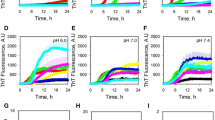Abstract
Injections of insulin are the main treatment for diabetes, but in the long run this therapy can induce serious drawbacks. This has inspired new drugs able to decrease insulin requirements. For instance, human amylin (hIAPP) is a small hormone cosecreted by pancreatic β-cells with insulin to which is a synergistic partner. However, the high amyloidogenicity of hIAPP precluded it as a therapeutics and led to the design of pramlintide (sIAPP), a chimeric analogue with substitutions (A25P, S28P, and S29P) inherited from the aggregation-resistant rat isoform (rIAPP). Despite sIAPP advantages, it still shares with hIAPP a poorly soluble profile at physiological pH that hampers its mixture with insulin. Recent improvements, as charge-enhanced mutants, have been proposed. For instance, sIAPP+ was screened in silico by purely microcanonical thermostatistical methods and adds to sIAPP an S20R mutation to uplift its solubility. This suggests that such physically inspired computational approach may also be auspicious on devising effective coformulations of insulin with amylin analogues. In this seminal attempt, we make comparative multicanonical simulations of regular acting human insulin coformulated with hIAPP, sIAPP, or sIAPP+. To assess the respective physicochemical stabilities against aggregation, we characterize the structural-phase transitions through the microcanonical thermodynamic formalism and evaluate their time lags using the classical nucleation theory. These results are then correlated with estimates of solvation free energies, modeled by the Poisson-Boltzmann equation, and structural propensities. Experimental essays are compared to our simulations and support our methodology.




Similar content being viewed by others
Data availability
Data may be provided by contacting the corresponding author. Software may be provided by contacting the corresponding author
References
Melmed S, Polonsky KS, Larsen PR, Kronenberg HM (2001) Williams textbook of endocrinology. Elsevier/Saunders; American Diabetes Society: http://www.diabetes.org/
NDC Risk Factor Collaboration (2016) Worldwide trends in diabetes since 1980: a pooled analysis of 751 population-based studies with 4.4 million participants. Lancet 387:1513–1530
Lipska KJ, Hirsch IB, Riddle MC (2017) Human insulin for type 2 diabetes an effective, less-expensive option. JAMA 318:23–24
Weyer C, Fineman MS, Strobel S, Shen L, Data J, Kolterman OG, Sylvestri MF (2005) Properties of pramlintide and insulin upon mixing. Am J Health-Syst Pharm 62:816–822
Westermark P, Andersson A, Westermark GT (2011) Islet amyloid polypeptide, islet amyloid, and diabetes mellitus. Physiol Rev 91:795–826
Abedini A, Schmidt AM (2013) Mechanisms of islet amyloidosis toxicity in type 2 diabetes. FEBS Lett 587:1119–1127
Akter R, Cao P, Noor H, Ridgway Z, Tu LH, Wang H, Wong AG, Zhang X, Abedini A, Schmidt AM, Raleigh DP (2016) Islet amyloid polypeptide: structure, function, and pathophysiology. Journal of Diabetes Research, Article ID 2798269
Jaikaran ETAS, Clark A (2001) Islet amyloid and type 2 diabetes: from molecular misfolding to islet pathophysiology. Biochim Biophys Acta 1537:179–203
Luca S, Yau WM, Leapman R, Tyckom R (2007) Peptide conformation and supramolecular organization in amylin fibrils: constraints from solid-state NMR. Biochemistry 46:13505–13522
Gilead S, Wolfenson H, Gazit E (2006) Molecular mapping of the recognition interface between the islet amyloid polypeptide and insulin. Angew Chem Int Ed 45:6476–6480
Wei L, Jiang P, Yau YH, Summer H, Shochat SG, Mu Y, Pervushin K (2009) Residual structure in islet amyloid polypeptide mediates its interactions with soluble insulin. Biochemistry 48:2368–2376
Baram M, Gilead S, Gazit E, Miller Y (2018) Mechanistic perspective and functional activity of insulin in amylin aggregation. Chem Sci 9:4244–4252
Bower RL, Hay DL (2016) Amylin structure–function relationships and receptor pharmacology: implications for amylin mimetic drug development. British. J Pharm 173:1883–1898
Hollander PA, Levy P, Fineman MS, Maggs DG, Shen LZ, Strobel SA, Weyer C, Kolterman OG (2003) Pramlintide as an adjunct to insulin therapy improves long-term glycemic and weight control in patients with type 2 diabetes. Diabetes Care 26:784–790
Riddle M, Frias J, Zhang B, Holly M, Brown C, Lutz K, Kolterman O (2007) Pramlintide improved glycemic control and reduced weight in patients with type 2 diabetes using basal insulin. Diabetes Care 30:2794–2799
Green J, Goldsbury C, Mini T, Sunderji S, Frey P, Kistler J, Cooper G, Aebi U (2003) Amyloidogenesis of the amylin analogue pramlintide. J Mol Biol 326:1147–1156
da Silva DC, Fontes GN, Erthal LCS, Lima LMTR (2016) Amyloidogenesis of the amylin analogue pramlintide. Biophys Chem 219:1–8
da Silva DC, Lima LMTR (2018) Physico-chemical properties of co-formulated fast-acting insulin with pramlintide. Int J Pharm 547:621–629
Wang H, Abedini A, Ruzsicska B, Raleigh DP (2014) Rationally designed, nontoxic, nonamyloidogenic analogues of human islet amyloid polypeptide with improved solubility. Biochemistry 53:5876–5884
Cao P, Tu LH, Abedini A, Levsh O, Akter R, Patsalo V, Schmidt AM, Raleigh DP (2012) Sensitivity of amyloid formation by human islet amyloid polypeptide to mutations at residue-20. J Mol Biol 421:282–295
Sinesia C, Nascimento CVMF, Lacativa PGS, Lima LMTR (2019) Physico-chemical stability of co-formulation of PEGylated human amylin with insulin. Pharm Dev Technol 24:975–981
Henriksen K, Karsda MA (2020) Supramolecularly stabilized diabetes drugs. Nat Biomed Eng 4:481–482
Smaoui MR, Orland H, Waldispuhl J (2015) Probing the binding affinity of amyloids to reduce toxicity of oligomers in diabetes. Bioinformatics 31:2294–2302
Gross DHE (2001) Microcanonical thermodynamics. World Scientific, Singapore
Bachmann M (2014) Thermodynamics and statistical mechanics of molecular systems. Cambridge University Press, UK
Junghans C, Bachmann M, Janke W (2006) Microcanonical analyses of peptide aggregation processes. Phys Rev Lett 97:218103
Frigori RB, Rizzi LG, Alves NA (2013) Microcanonical thermostatistics of coarse-grained proteins with amyloidogenic propensity. J Chem Phys 138:015102
Frigori RB (2014) Breakout character of islet amyloid polypeptide hydrophobic mutations at the onset of type-2 diabetes. Phys Rev E: Stat Nonlinear Soft Matter Phys 90:052716
Frigori RB (2017) PHAST: protein-like heteropolymer analysis by statistical thermodynamics. Comput Phys Commun 215:165–172
Hernandez-Rojas J, Gomez Llorente JM (2008) Microcanonical versus canonical analysis of protein folding. Phys Rev Lett 100:258104
Frigori RB (2017) Be positive: optimizing pramlintide from microcanonical analysis of amylin isoforms. Phys Chem Chem Phys 19:25617–25633
Alves NA, Frigori RB (2018) In silico comparative study of human and porcine amylin. J Phys Chem B 122:10714–10721
Alves NA, Frigori RB (2019) Synergistic long-range effects of mutations underlie aggregation propensities of amylin analogues. J Mol Model 25:263
Abedini A, Raleigh DP (2009) A critical assessment of the role of helical intermediates in amyloid formation by natively unfolded proteins and polypeptides. Protein Eng Des Select 22:453–459
Williamson JA, Loria JP, Miranker AD (2009) Helix stabilization precedes aqueous and bilayer-catalyzed fiber formation in islet amyloid polypeptide. J Mol Biol 393:383–396
Zierenberg J, Marenz MW (2013) Scaling properties of a parallel implementation of the multicanonical algorithm. Comput Phys Commun 184:1155–1160
Berg BA, Neuhaus T (1991) Multicanonical algorithms for first order phase transitions. Phys Lett B 267:249–253
Meinke JH, Mohanty S, Eisenmenger F, Hansmann UHE (2008) SMMP v. 3.0 — simulating proteins and protein interactions in Python and Fortran. Comput Phys Commun 178:459–470
Jiang P, Yaşar F, Hansmann UHE (2013) Sampling of protein folding transitions: multicanonical versus replica exchange molecular dynamics. J Chem Theory Comput 9:3816–3825
Peng E, Todorova N, Yarovsky I (2017) Effects of forcefield and sampling method in all-atom simulations of inherently disordered proteins: application to conformational preferences of human amylin. PLOS One 12:e0186219
Fokin VM, Yuritsyn NS, Zanotto ED (2005) Nucleation theory and applications. Wiley-VCH Verlag GmbH & Co (GER)
Jo S, Kim T, Iyer VG, Im W (2008) CHARMM-GUI: a web-based graphical user interface for CHARMM. J Comput Chem 29:1859–1865
Im W, Beglov D, Roux B (1998) Continuum solvation model: computation of electrostatic forces from numerical solutions to the Poisson-Boltzmann equation. Comput Phys Commun 111:59–75
Jo S, Vargyas M, Vasko-Szedlar J, Roux B, Im W (2008) PBEQ-solver for online visualization of electrostatic potential of biomolecules. Nucl Acids Res 36:W270–275
Dodson G, Steiner D (1998) The role of assembly in insulin’s biosynthesis. Curr Opin Struct Biol 8:189–194
Meinke JH, Hansmann UHE (2007) Aggregation of β-amyloid fragments. J Chem Phys 126:014706–1–5
Rizzi LG (2020) Kinetics of first-order phase transitions from microcanonical thermostatistics. J Stat Mech 8:083204–22
Hojjati H, Rohani S (2006) Measurement and prediction of solubility of paracetamol in water-isopropanol solution. Org Process Res Dev 10:1110–1118
Privalov PL (1979) Stability of proteins: small globular proteins. Adv Protein Chem 33:167–241
Acknowledgments
The Brazilian National Laboratory for Scientific Computing (LNCC) is acknowledged by supercomputing time granted at the Santos Dumont facility under project PHAST2. We thank both anonymous reviewers for constructive comments.
Funding
This study was financed in part by the Coordenação de Aperfeiçoamento de Pessoal de Nível Superior - Brasil (CAPES) - Finance Code 001.
Author information
Authors and Affiliations
Contributions
F.R. computer simulations and data analysis. R.B.F. study design, computer simulations, data analysis, and wrote the article.
Corresponding author
Ethics declarations
Conflict of interest
The authors declare that they have no conflict of interest.
Additional information
Publisher’s note
Springer Nature remains neutral with regard to jurisdictional claims in published maps and institutional affiliations.
Appendix
Appendix
Trustworthy estimating the multicanonical parameters \(\left \{ {\upbeta }_{k},\alpha _{k}\right \} \) for complex oligomeric systems is well-known to be a cumbersome task in serial simulations. We overcome this numerical hindrance by performing massive parallel simulations with the MUCA algorithm devised in [31, 36]. Thus, it would be interesting to provide an illustrative example of how fast the convergence may be established. Figure 5 presents, for a system composed by insulin in a coformulation with sIAPP+, the microcanonical entropy \(S\left (\varepsilon \right )\) defined by Eq. 3 as a function of the number of sweeps. Multicanonical parameters are updated every 120k Monte Carlo sweeps, sampled in parallel with 1200 CPUs. The simulation clearly converged for the whole energetic range of interest (i.e., − 5.0 ≤ ε ≤− 4.0) after nearly 5M sweeps, since then \(S\left (\varepsilon \right )\) gets stabilized. To further ensure the convergence and collect configurations, we accomplished 15M sweeps. Moreover, once the entropy is established the whole microcanonical thermodynamics is derived by the PHAST package [29].
Rights and permissions
About this article
Cite this article
Frigori, R.B., Rodrigues, F. Microcanonical insights into the physicochemical stability of the coformulation of insulin with amylin analogues. J Mol Model 27, 28 (2021). https://doi.org/10.1007/s00894-020-04617-9
Received:
Accepted:
Published:
DOI: https://doi.org/10.1007/s00894-020-04617-9





